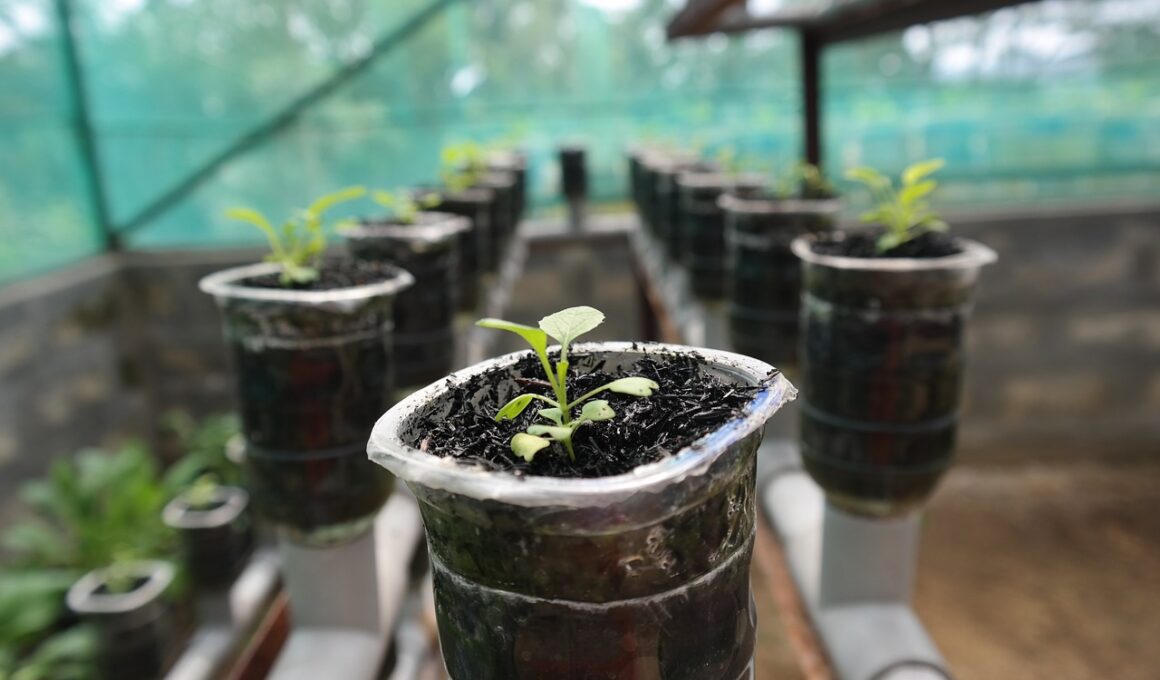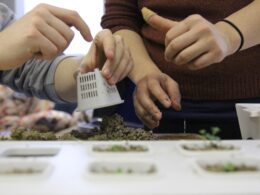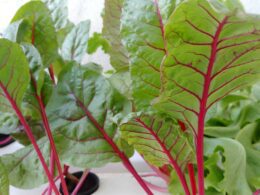Do you want to grow your own fresh produce but don’t have access to fertile soil? Hydroponics might be the answer you’re looking for.
Hydroponic systems allow you to grow plants without soil, using nutrient-rich water instead. But do you need to use dirt in hydroponics? Let’s explore this topic and find out more about the different growing mediums that you can use.
First, let’s understand what hydroponics is. Hydroponics is a method of growing plants in a controlled environment, such as a greenhouse, using water, nutrients, and a growing medium. The plants are grown in a soil-free environment, which means there’s no need to till soil or deal with weeds. This makes hydroponics a popular choice for urban gardeners and those who want to grow fresh produce indoors.
But if you’re new to hydroponics, you might be wondering whether you still need to use dirt to grow your plants. Let’s dive deeper into this topic and explore your options.
Understanding Hydroponic Systems
Get ready to discover the fascinating world of hydroponic systems and how they can help you grow your plants faster and more efficiently. Hydroponic systems are a method of growing plants without soil, instead using hydroponic nutrient solutions to provide the plants with the necessary nutrients.
There are different types of hydroponic systems, each with their own advantages and disadvantages. One of the main benefits of hydroponic systems is that they allow for precise pH management in hydroponics. The pH level of the nutrient solution is crucial for plant growth, as it affects the availability of nutrients.
In a hydroponic system, the pH level can be easily monitored and adjusted, ensuring that the plants are getting the nutrients they need. This level of control over the pH level is not possible in traditional soil-based growing methods.
Overall, hydroponic systems are a great option for those looking to grow plants in a more controlled and efficient way. With the ability to precisely manage the pH level of the nutrient solution, you can ensure that your plants are getting the nutrients they need to thrive. So if you’re looking for a new way to grow your plants, consider exploring the world of hydroponic systems.
Growing Mediums in Hydroponics
When it comes to hydroponics, choosing the right growing medium is crucial for the success of your plants. Among the most commonly used growing mediums in hydroponics are coconut coir, perlite, rockwool, and vermiculite. Each medium has its own set of pros and cons that you need to consider before deciding which one to use.
Coconut coir is a renewable resource that is easy to use and is great for water retention. However, it can be difficult to find a good quality coconut coir that is free from salt and other contaminants.
Perlite, on the other hand, is readily available and is ideal for aeration and drainage. But, it can be a bit messy and may require frequent replacement.
When it comes to rockwool and vermiculite, the question of which is better has been a topic of debate in the hydroponics community. Rockwool is great for root support and is easy to use, but it can be expensive and may have a negative impact on the environment.
Vermiculite, on the other hand, is a natural mineral that is affordable and great for water retention. However, it may not be as effective as rockwool when it comes to root support.
In choosing the right growing medium for your hydroponics system, consider the needs of your plants and your personal preferences. Weigh the pros and cons of each medium and choose the one that suits your needs best. Remember, the success of your hydroponics system depends on the quality of your growing medium.
Alternatives to Soil in Hydroponics
If you’re looking to explore new options beyond traditional soil-based growing, you’ll be excited to learn about the various alternatives to soil available in hydroponics. Here are four alternatives that you might want to consider:
-
Coir: This is a natural fiber extracted from coconut husks. It’s an excellent alternative to soil because it’s lightweight, porous, and retains water well. Coir is also pH neutral, so you won’t have to worry about adjusting the pH level of your nutrient solution.
-
Rockwool: This is a popular alternative to soil because it’s easy to work with and provides good support for plant roots. It’s made from volcanic rock and is available in various sizes and shapes. Rockwool is pH neutral and can be reused multiple times.
-
Aeroponics: This method of hydroponics involves suspending plant roots in the air and misting them with nutrient-rich water. It’s an excellent alternative to soil because it allows for higher oxygen levels around the roots, which promotes faster growth and higher yields. Aeroponics also uses less water than other hydroponic methods.
-
Benefits of Aeroponics: Aeroponics is a highly efficient method of growing plants because it uses less water and requires less space than traditional soil-based growing. It’s also a more environmentally friendly option because it doesn’t require the use of pesticides or herbicides. Additionally, aeroponics allows for greater control over the nutrient levels and pH balance of your plants, which can lead to healthier, more robust growth.
Incorporating alternatives to soil in hydroponics can be a great way to explore new growing methods and increase your yields. Whether you choose coir, rockwool, aeroponics, or another alternative, be sure to do your research and choose the option that best fits your needs and growing goals. With a little experimentation, you’ll be well on your way to a successful hydroponic garden.
Does the Use of Soil Affect the Taste of Hydroponically Grown Strawberries?
The taste of strawberries in soil vs hydroponics can differ due to the contrasting growing conditions. Soil-grown strawberries draw nutrients from the earth, which may impart distinctive flavors. Meanwhile, hydroponic strawberries receive nutrients directly in water, potentially influencing their taste. Thus, the choice between growing methods can impact the flavor profile of strawberries.
Choosing the Right Growing Medium
When choosing the right growing medium for your hydroponic garden, there are several factors you should consider. These include the type of plants you want to grow, your budget, and the availability of the growing medium.
It’s important to match the growing medium to the plant’s specific needs to ensure successful hydroponic gardening. Here are some tips to help you choose the right growing medium for your plants.
Factors to Consider
Factors to consider include the type of plants being grown, the nutrient solution being used, and the size and type of hydroponic system being utilized. Different plants have different requirements when it comes to pH levels and nutrient solutions. For example, some plants prefer a slightly acidic pH, while others require a more alkaline environment. It’s important to research the specific needs of the plants you’re growing and adjust the pH levels and nutrient solutions accordingly.
Additionally, the size and type of hydroponic system being used can also play a role in the type of growing medium that should be used. When choosing a growing medium, here are a few factors to consider:
- The water retention capabilities of the medium
- The level of aeration within the medium
- The pH buffering capacity of the medium
By considering these factors, you can ensure that your plants are getting the right amount of water, oxygen, and nutrients to thrive in your hydroponic system. Remember, the type of growing medium you use can have a significant impact on the overall success of your hydroponic garden.
Matching Growing Mediums to Plant Needs
Matching the right growing medium to your plants’ specific needs can make all the difference in the success of your hydroponic garden. When choosing the right plants for your hydroponic setup, it’s important to consider their specific requirements.
Some plants prefer a loose, airy medium like perlite or vermiculite, while others thrive in a denser medium like coco coir or rockwool. Matching your plants to the right medium can help ensure their roots receive the right amount of oxygen and nutrients.
In addition to choosing the right medium for your plants, using organic nutrients can provide several benefits. Organic nutrients are derived from natural sources, such as compost or worm castings, and can help improve soil structure and fertility.
When used in hydroponics, organic nutrients can help promote healthy plant growth and improve the quality of your harvest. By matching your growing medium to your plants’ needs and using organic nutrients, you can create a thriving hydroponic garden that produces delicious, healthy crops.
Tips for Successful Hydroponic Gardening
Now that you know how to match growing mediums to your plant’s needs, let’s move on to some tips for successful hydroponic gardening.
If you’re new to hydroponics, you might be wondering what the benefits are. For starters, hydroponics allows you to grow plants in a controlled environment, with no need for soil. This means you can grow plants year-round, regardless of the weather outside. It also means you can grow plants in areas where soil quality is poor or non-existent.
However, there are common mistakes in hydroponic gardening that can lead to plant damage or failure. One of the most common mistakes is not monitoring the pH level of your nutrient solution. If the pH is too high or too low, your plants won’t be able to absorb the nutrients they need.
Another mistake is not providing enough oxygen to the roots, which can cause root rot.
By following these tips and avoiding common mistakes, you’ll be on your way to a successful hydroponic garden.
Maintaining Your Hydroponic System
Keeping your hydroponic system in top condition is crucial for achieving healthy and vibrant plants that’ll leave you feeling proud and accomplished.
pH management is one of the most important aspects of maintaining your hydroponic system. The pH level of your nutrient solution should be between 5.5 and 6.5 for most plants. Regularly measuring the pH level with a meter and adjusting it with pH up or down solutions will ensure that your plants are getting the right nutrients they need.
Another significant aspect of maintaining your hydroponic system is taking care of your nutrient solutions. Nutrient solutions should be changed every 1-2 weeks to prevent the buildup of salts and other minerals that can harm your plants. When changing the solution, it’s important to also clean the reservoir and tubing to prevent the growth of algae and bacteria.
It’s also important to use high-quality nutrient solutions that provide the necessary macro and micronutrients that your plants need to thrive.
In addition to pH management and nutrient solutions, you should also regularly check your hydroponic system for any signs of damage or malfunction. Leaks, clogs, and other issues can quickly lead to plant damage or even complete system failure. Regularly inspecting your system and addressing any issues promptly will help ensure that your plants stay healthy and your hydroponic system continues to operate efficiently.
By following these tips, you can maintain your hydroponic system and achieve healthy and vibrant plants that’ll make you proud.
Frequently Asked Questions
Can dirt be used as a growing medium in hydroponics?
Using soil as a growing medium in hydroponics can be done, but it’s not recommended. While soil may contain nutrients that plants need to grow, it can also harbor harmful pathogens that can infect your plants. Additionally, soil can clog up your hydroponic system and make it difficult to maintain proper pH and nutrient levels.
If you do choose to use soil, make sure to sterilize it first to kill any harmful bacteria or fungi. Overall, there are better alternatives to using dirt in hydroponics, such as coconut coir or peat moss, which are less likely to cause problems and can still provide the necessary support and nutrients for your plants to grow.
What are the benefits of using alternative growing mediums in hydroponics?
If you’re looking for a way to grow plants without using soil, hydroponics is the answer. But did you know that there are several alternative growing mediums that can be used instead of dirt?
These mediums offer a variety of benefits, such as better water retention, improved aeration, and increased nutrient uptake. Some popular alternative growing mediums include rockwool, coco coir, perlite, and vermiculite. Each medium has its own unique properties that can be tailored to specific plant needs.
By using these alternative growing mediums, you can create a more efficient and productive hydroponic system for your plants. So, if you’re looking to take your hydroponic setup to the next level, consider exploring the benefits of these alternative growing mediums.
How do you choose the right growing medium for your hydroponic system?
Choosing the right growing medium for your hydroponic system is crucial for successful plant growth. One important factor to consider is pH management, as different mediums have varying pH levels that can affect nutrient absorption.
Another factor to consider is the ability of the medium to hold water and oxygen, as this affects the plant’s ability to grow and thrive. When choosing a growing medium, it’s important to keep in mind the specific needs of the plants you’re growing and to select a medium that will provide the necessary support and nutrients.
By carefully selecting the right growing medium, you can ensure healthy plant growth and a successful hydroponic system.
What are some common issues that can arise when using a hydroponic system with a non-soil growing medium?
When using a non-soil growing medium in your hydroponic system, there are some common issues that can arise. One of the most important things to consider is pH level maintenance. Since the pH level can significantly affect the availability of nutrients, it’s essential to regularly monitor and adjust it to ensure that your plants receive the proper nutrients they need.
Nutrient deficiency is another common issue that can occur when using a non-soil growing medium. This can happen when the nutrients in the solution are not properly balanced or when the plants are not absorbing the nutrients effectively. By regularly checking the nutrient levels and adjusting them accordingly, you can prevent nutrient deficiencies and ensure healthy plant growth in your hydroponic system.
How often should you replace the growing medium in your hydroponic system?
If you’re using a hydroponic system, it’s important to know when to replace the growing medium to ensure healthy plant growth. The frequency of replacement depends on the type of medium you’re using and the crop you’re growing, but generally, it’s recommended to replace the medium every 1-2 years.
This helps prevent nutrient imbalances and disease buildup. Suitable alternatives to traditional growing mediums like soil include coco coir, peat moss, and perlite. When choosing a replacement medium, consider factors like water retention, pH balance, and nutrient availability.
By regularly replacing your hydroponic growing medium with a suitable alternative, you can ensure your plants are healthy and thriving.
Conclusion
So, do you use dirt in hydroponics? The answer is no. Hydroponic systems use water and nutrients to grow plants without soil. Instead, they use a variety of growing mediums such as perlite, coconut coir, and rockwool.
When choosing a growing medium, it’s important to consider factors such as pH levels, water retention, and aeration. Maintaining your hydroponic system is also crucial for the success of your plants. This includes regularly monitoring pH levels and nutrient levels, as well as proper water and air circulation.
By understanding the basics of hydroponics and choosing the right growing medium, you can have a successful and thriving hydroponic garden without the use of dirt.
So, get started on your hydroponic journey and see the benefits for yourself!









